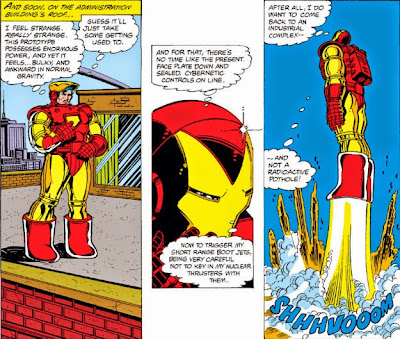Welcome to Part Two of our look at a few stories presented within the pages of Incredible Hulk where writer Bill Mantlo throws the spotlight on super-heroes which originated in countries to the east of the Atlantic. While Glenn Talbot was pursuing his one-man vendetta against the Hulk and tracking the brute across international borders, the Hulk would find himself in Israel and have an altercation with that country's heroine, Sabra, before leaping away and heading in the direction of Egypt.
And yet, it's not the Hulk whom we find languishing in that country's great eastern desert, but rather his human alter-ego, Bruce Banner, who possesses neither the Hulk's endurance nor his ability to transcend great distances by leaps and bounds:
These stories are something of a treat for any reader who's fond of seeing an artist ink their own pencils--in this case, Sal Buscema, whose work at Marvel speaks for itself. Buscema inking his own work can be a mixed blessing--for while his ability to pack a great deal of imagery into his scenes is one of the hallmarks of his style, his work could still benefit from a strong finisher who would "smooth out the rough edges," so to speak. Take that splash page above, for instance. Buscema adds such nice touches, like keeping the approaching riders in shadow--not only as a way to keep us guessing for the time being as to what their intentions are, but also depicted thus because the blazing sun is behind them; and as for that sun, you can almost feel the strength of it radiating right off the page. But, does that look like sand to you--or does it remind you more of bed linen? There are aspects to Buscema's pencilling that would never occur to Buscema the inker to improve on.
Banner has been found by a man named Abdul, who takes him to recuperate at his family's tent:
(Another example of Buscema's casual skill--Abdul's wife might seem as though she's dozing, but Buscema draws the panel in such a way that it's clear she's busy tending to Banner's nourishment, even with her bulky garment hiding her movements.)
Abdul looks to be part of an archaeological expedition put together by noted scientist Hassan Kareem, who believes he has discovered the tomb of two demons of Egyptian myth--Gog and Magog, who sought to take revenge against the Israelites for the deeds of Moses against the pursuing cavalry of Pharaoh. But before they could act, they were captured and entombed by the new Pharaoh, who wanted nothing more to do with Moses and his god:
As the story progresses, we start to hear in Kareem's words an apparent bias against Israel, for reasons unknown. He's spent nearly a lifetime to uncover both the legend and the location of these two demons--and when he at last reveals the tomb for all to see, it becomes clear that his motives go beyond mere scientific curiosity:
Mantlo seems to place a great deal of stock in the buildup for Gog and Magog, with the scene above mimicking a similar scene earlier in the story where Abdul and Banner are shown the rockface entrance to the tomb. And yet, these demons were handily captured by the Pharaoh's men, armed with little more than spears--how formidable can they be?
Kareem's revelation of the tomb seems to trigger an earthquake, which traps Kareem with the sarcophaguses of the demons (which he appears to be just fine with) and separates Abdul and Banner. Though Abdul, you may have guessed, has a greater destiny to discover within the tomb:
Abdul's mysterious discovery comes just in time, because Gog and Magog have been freed by the quake and now move to attack the workers outside. As for Banner, an earthquake and cave-in have a way of making a person fear for their life--and as we've seen before, fear and panic have quite an effect on Robert Bruce Banner:
But the demons' attack on the Hulk is halted by a startling sight above them--that of Abdul, who has assumed the legacy of the man now revealed to be his ancestor:
It's understandable if this story reads like something which should be taking place in Marvel Team-Up, a book which Buscema had also worked on. Gog and Magog are threatening enough, but they seem to exist in this story mostly to provide the Knight's abilities with a little exposure. It certainly doesn't appear they present a challenge to the Hulk (as the Knight would later note himself):
And as for any suggestion that the Hulk might think of the Knight as a comrade-in-arms:
Nevertheless, the Knight knows a valuable ally when he sees one, and the Hulk's relentless attack against these demons paves the way for resealing them in their tomb. But that goal is complicated by the fact that the Hulk prefers to crush his enemies in his own manner:
With the Knight's raison d'être no longer present, you'd think the powers of the scimitar and rug would vanish as well--but it looks like the Arabian Knight is here to stay. The Hulk, on the other hand, isn't sticking around in Egypt--he's off to Soviet-occupied Afghanistan, though he'll drop in soon enough on the U.S.S.R. where he'll meet the Soviet Super-Soldiers. Sheesh--maybe this book is Marvel Team-Up, after all!
 | Incredible Hulk #257 Script: Bill Mantlo Pencils and Inks: Sal Buscema Letterer: Jim Novak |























































